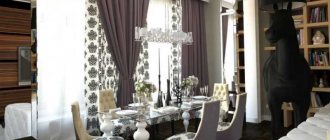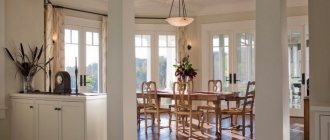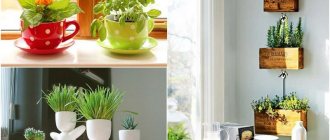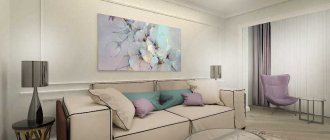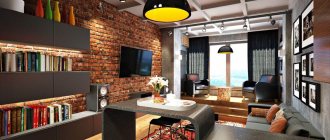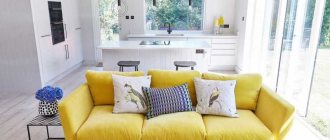Classics of the genre
The chaos of flower pots is a sad sight, regardless of whether they stand on the windowsill or on the chest of drawers. In order for green spaces to look decorative and not burden the interior, a well-thought-out concept is needed. First, select the plants that you like best, and then build a display with interesting flower pots. However, you can plant flowers beautifully in ordinary plastic pots - the main thing is that their color matches other interior elements.
Photo: amazon.co.uk
Requirements for containers for flowers
The most important function of a flower pot is not to decorate the interior, but to protect the root part of the plant from external influences and create a certain “island” of soil in which the bush will feel cozy and good. When choosing pots and flowerpots for house plants, you should not focus on their appearance, although this is certainly a very important factor, no matter what
But if caring for plants comes first (after all, they are also living), then it is important to pay attention not only to the appearance of the container, but also to its other features - how suitable is the pot for growing plants in it? In order not to make a mistake in choosing, and also to make a suitable and correct pot with your own hands, you need to know what the right pot for a plant should be
DIY flower pot decorOriginal flower pots
When choosing containers for plants, you need to focus on:
- shape;
- size;
- material of manufacture;
- practicality;
- appearance.
There are a number of criteria for choosing flower pots
Idea for beautiful decor of flower pots
Unusual flower pots made from wooden clothespins
In order to choose the right container, first of all you need to study the literature regarding the flower being transplanted. Some plants prefer large and spacious pots, while others prefer small and cramped ones. There are variations with wide diameter but low pots, as well as, conversely, narrow and tall ones. All advice regarding containers will be specified in the recommendations for the growing conditions of a particular plant.
Original DIY flower pot decor
The basic requirements for flower pots can be studied in the table below.
Table. Requirements for pots and flowerpots.
Requirement Description
The presence of drainage holes A drainage hole should be in any pot, and it does not matter which plant is replanted - a moisture-loving one or one that prefers dryness. In clay pots there is usually only one hole and is located in the middle of the bottom
Plastic ones may have several holes across the entire bottom area. And some plants even need drainage on the sides of the containers.
Possibility of easy cleaning Often, when a plant grows out of its pot, the container, after replanting the previous resident, is “inherited” by another, smaller flower. Here, before planting in an old pot, it needs to be thoroughly cleaned and rinsed. It is bad if the material cannot be thoroughly cleaned of old soil, and doubly bad if a diseased plant lived in it before.
Volume, shape, size The shape of the pot can be any, although it is preferable to choose square or round. As for volume and size, they are selected depending on the plant being planted. Regarding the size, you can focus on the parameters of the root part - it should not be cramped, otherwise the roots will not develop correctly and will no longer fully perform their functions.
Stability The pot in any case should be as stable as possible. If it accidentally falls, the plant may lose its above-ground part, and then there is a high probability of death of the green pet. Moreover, for plants with a large above-ground part, it is very important to take stable pots and preferably with a wide bottom.
Material From time immemorial it has been known that the best material for making a pot is ordinary clay. But any breathable porous material will also work. The roots of the plant must be able to breathe; they also need air. In some cases, you can use metal or plastic pots, but this is not always a good option.
Photos of DIY flower pots
Spectacular and unusual flower pots
Hanging flower pots
Simple and beautiful
Calculate the exact cost of repairs using an online calculator
and receive a free detailed estimate for repairs
Calculate
When creating an unusual composition of indoor plants on the windowsill, you should not take assorted flower pots. It’s better to let them be the same in color and material, but different shapes. By the way, you need to adhere to such a plan when landscaping the entire interior, and not just the window sill.
Photo: pricearchive.org
Criteria for choosing a pot for a houseplant
When selecting a flowerpot, take into account the size of the root system and the entire bush. The shape of the pot is of considerable importance - if necessary, it should ensure careful removal of the clod of earth when replanting the plant using the transshipment method. The material used to make the product also largely determines the choice. For example, if the flower you are about to grow has a fragile root system, a “breathing” pot made of unglazed ceramic will do. For a palm tree or monstera with a well-developed crown, you need a heavy, stable flowerpot.
Pot height and diameter
Recommended by topic
Epipremnum Light-loving plants for home and garden Balsam
When making most flower pots, manufacturers adhere to the usual proportions: the diameter of the upper edge and the height of the products have approximately the same values, and the container narrows towards the bottom. Such dimensions correspond to the shape of the root system of many plants, reduce the consumption of nutrient substrate and prevent stagnation of water in its lower part.
But flowerpots with non-standard sizes are also produced: low and wide for species with shallow roots that produce numerous offspring. You can also plant a composition of several compact cacti and ground cover plants in them, or use them to create bonsai. If the diameter at the bottom is much smaller than the width at the top, such pots may be less stable and may tip over, especially when growing large specimens with a spreading crown.
The height and diameter of the pot are selected in accordance with the structure of the root system
In addition, you can find elongated pots with a height significantly greater than the diameter. They are suitable for flowers with a taproot system.
If it is necessary to plant a plant with short fibrous roots in such a flowerpot, a significant layer of drainage material, such as expanded clay, should be poured onto the bottom in a layer of 5–15 cm. This will ensure that excess moisture is removed from the soil and it is saturated with air through the drainage holes.
Pot volume
The volume of the flowerpot should ensure the free position of the roots so that when transplanting they can be distributed in the soil at some distance from each other. This way they will have enough space to grow and receive nutrients. But the volume of the pot should not significantly exceed the size of the root system or the lump of earth entwined with it during transshipment. As a rule, a new pot is selected in such a way that its capacity is 20% larger than the previous one.
If you take a container with a smaller volume, the roots will be cramped and the plant will develop worse. If you use a flowerpot that is too large, the root system will have to spend a lot of time to develop it, and the risk of rotting will also increase due to stagnant moisture and poor air access.
Some species (for example, Saintpaulia and geranium) do not bloom for a long time due to planting in an overly large container.
Pot shape
Despite the significant variety of container shapes for growing indoor plants, gardeners often use pots in the form of a truncated cone as the most rational and easy to use. But to add variety to the interior of a room or the exterior of a personal plot, you can plant flowers in more original products. For example, experiments with materials for making unusual pots expand the scope for your own imagination and help bring interesting ideas to life.
Flowerpots can have a wide variety of shapes
According to the shape, flower containers can be divided into the following groups:
- Frustum. Allows you to easily release the root system during transplantation, both as carefully as possible with a lump of earth, and without it. Ideal for species with fragile roots, protecting them from damage, drying out and waterlogging.
- Rounded. They are very decorative, they decorate the interior, but the distance from the walls of the pot to the roots in this case is quite large. This impairs gas exchange, but when made from fired clay it is less dangerous than when using glazed ceramics, due to the presence of pores that allow water and air to pass through. Less practical are “pot-bellied” flowerpots with a tapering upper edge, since it is quite difficult to get roots out of them without damaging them.
- In the shape of a square or rectangle. They are often made from concrete or plaster. They look impressive in the garden or yard and fit perfectly into a high-tech or loft style interior. Such flowerpots are very stable and spacious; they are suitable for large plant specimens, for example, adult palm trees, small trees or shrubs with a voluminous crown.
- In the form of a more complex geometric figure, repeating the contours of an animal or household item. Such pots are intended for decorative decoration of space; they are usually made of plastic or polymer clay. The presence of corners and bends in these products sometimes reduces capacity and prevents free growth of roots. It is important that there are drainage holes at the bottom of the container. In their absence, watering should be very moderate and superficial, for example using a sprayer.
Special trays are used to collect excess water released through the drainage holes. Sometimes they are sold complete with a flower pot or separately from it.
Sufficiently wide and deep glazed ceramic trays are also used as containers for growing bonsai; ordinary ones can also be used as a stand for kokedama - a type of floristry in which plants are planted in a spherical ball of nutrient substrate wrapped in moss.
Flowerpots are also used to place ordinary flower pots. They also allow you to remove excess water when watering, as well as protect the roots from cold air or overheating.
Pot material
Various materials are used to make pots. They differ not only in appearance, but also in quality. When selecting a flowerpot, you should consider whether its material has properties that ensure the full development of the indoor plant. Most often, flower pots are made of ceramics, plastic, glass, concrete, artificial stone, wood, and metal.
Magic of light
For the latest romantics and lovers of a warm lamp atmosphere, luminescent flower pots will be a godsend. Such luminous flowerpots will serve you not only for their intended purpose - they will create a magical atmosphere in the room at night, no worse than a night light.
Photo: privatehomes.com
Photo: gartenplanet.de
Family photo
What if you decorate old flower pots with family photos? For example, decorate each pot with photographs of all family members - you will get the original composition “Mom, Dad, Me - a flower family.” Choose a “green hairstyle” for everyone - and you’ll get a real floral masterpiece. In addition, with this approach, you can teach your household to care for flowers - after all, if you don’t water your hair, it will begin to fade.
Photo: archicoutureblog.com
Macrame flowerpots
The technique of knotted weaving from thin rope, twine, yarn is macrame. Do-it-yourself macrame flowerpots are a garden decoration; by dressing flower pots in such a shell, we will truly create the gardens of Babylon. Everyone who gets into them will admire such beauty.
This type of weaving was invented by men. Don’t be surprised if you see the owner of the house making a similar craft.
This pot turns out to be a light and elegant item. By improving the technique of knot weaving, you will create multi-tiered flowerpots of unprecedented beauty.
Wherever macrame flower pots are attached, they look stylish and original. This is truly a universal item.
Metallic shine
Metal hanging pots will automatically make even the most neutral and laconic interior stylish. If your home lacks copper or silver shine, take note of this option. Moreover, metal is back in trend today.
Photo: housebeautiful.com
Kinds
Since flowerpots are used as decoration, the presence of a certain variety of this element allows you to choose the right option in each specific case. Let's look at the most popular ones.
A high pot is used for large plants that are planted in bulky pots. The most popular material for such products is rattan. This can be natural raw materials, which are made from rattan palms, or a plastic imitation. In addition, clay pots look beautiful, and they can be placed both indoors and outdoors. The advantage of this option is the ability to create such an interior item yourself.
- Hanging planters are used both indoors and outdoors. This option is convenient because it is possible to place flowers where there is no stationary support. Depending on the location, the material may vary. Almost any of the options are possible for the room, including something original, made with your own hands, for example, decor in the shape of a nest. For outdoor use, it is worth using reliable products made from high-quality plastic or metal that are not deformed by wind fluctuations.
- A table or floor planter is used as decoration indoors or in an open garden. At home, these can be flowerpots in the form of small decorative shoes, which are sold in the store. If you want to make the decor manually, you can use thin branches, the length of which will be slightly higher than the pot. With their help, the pot is lined around the perimeter, after which they are tied with twine. Decorative boots, which can be ceramic or rubber, will look very impressive in the garden.
- Wicker pot. Thanks to the use of various weaving techniques, including macrame, it is possible to use threads to create an original object of a particular style, for example, country. It is worth noting that the creation of such masterpieces requires a good level of proficiency in weaving techniques, so you will have to spend some time improving your abilities.
- Rope pots - this option is suitable for those who want to learn how to create beautiful wicker objects, but do not have the necessary skills. It is weaving from a thick rope that will help you master the basics and push you to new heights of creativity. Making a flowerpot from a rope is quite simple: you need to have a metal ring with a diameter of 12-15 cm, and a thick rope about 50 meters long. The weaving procedure in this case is a set of simple knots, with the help of which the desired product is created.
The versatility of the pots allows you to use almost any objects for work, which, with a rich imagination and skillful hands, turn into wonderful art objects.
Vertical gardening
It is not necessary to allocate a window sill for indoor plants. They can be placed vertically. Flowers in wall pots will be a worthy replacement for an expensive painting. This option is ideal for a house design project in eco-style.
Photo: homewowdecor.com
Photo: home-designing.com
Material of manufacture
Pots can be ceramic, glass, metal, or plastic. Each material has positive and negative sides.
Clay pots have not lost their popularity all over the world, although they have been used for many centuries. The ancient Egyptians first began to plant plants in them.
Vessels made from this material are ideal; thanks to their microscopic porosity, they promote the flow of oxygen to the roots, ensure the evaporation of moisture, and have sufficient weight and stability. The downside is the high price of clay products and fragility.
Plastic pots are in fashion today. They are widely popular among florists due to their bright appearance, variety of shapes and sizes, ease of care and low price.
The disadvantages of the material are the greenhouse effect, which promotes the formation of rot and the instability of the pot due to its low weight.
Glass and iron pots are not very popular, as glass is fragile and metal is susceptible to corrosion. Both materials retain moisture and prevent air exchange.
- DIY artificial flowers - the best original home interior design ideas
Volumetric paper flowers - diagrams, templates, decor options and DIY decorations
Scandinavian style sofa: photos of beautiful design and successful placement in the interior
The material of the pots is not significant for the comfort of the plant, and is chosen to your taste. Here the main selection criterion is the design and the place where the flowerpot will be located. There are floor and hanging options for their placement.
Charming miniatures
These cute little pots are sure to make you smile. A great idea for landscaping in a nursery's interior. Whether it's mini humans, a family of kittens, or a robot superhero, your little ones will love them!
Photo: home-designing.com
Photo: home-designing.com
Aquafarm
And this is not just a flower pot, this is a real ecosystem. Plants live beautifully in one part of it, and fish swim in the other. What you need for eco-style interiors. However, such potted decor will take root in any other modern interior.
Photo: thegadgetflow.com
How to choose pots and flowerpots for your interior
A harmonious combination of shapes, colors, sizes of flowerpots with interior items and its style unites the space, creating a feeling of comfort. For example, when decorating walls in strict black and white tones, round-shaped pots and monochromatic achromatic colors look elegant. To add stylish accents to the interior, use pots of rich colors or unusual shapes.
For identical plants standing next to each other, use flowerpots of the same shape and color or differing shades of color.
The color of the flowerpot should not be brighter than the leaves and inflorescences of the indoor flower growing in it. Any type of plant looks good in pots of neutral tones - white, beige, light brown, olive, brick, chocolate, gray. In one elongated flower pot you can place several small flowerpots.
The shape and material of the pot are also selected according to the interior style:
- Simple clay products look natural in a room decorated in a country style.
- Elegant porcelain and earthenware pots are ideal for a classic style.
- Round glass containers highlight the sophistication of Japanese minimalism.
- Wooden flower pots made from old driftwood or stumps look organic in the natural environment of eco-style.
- The cool shine of metal planters supports the functionality and practicality of high-tech.
- The strict form of concrete flowerpots corresponds to the brutality and negligence of the loft style.
- Colorful round pots made of plastic are appropriate in a cozy modern atmosphere.
When selecting a stand, the interior features are also taken into account. The shade of wooden racks should be in the same color scheme as the colors of the furniture. The color of forged stands can be contrasting or match the color of the walls or floor.
Tableware design
For houseplants with a shallow root system, even ordinary mugs, sugar bowls, and milk jugs can become an excellent home. For larger flowers, it is better to use other kitchen utensils, such as a teapot or jug. A great idea for a Provence style kitchen or loggia decor.
Photo: homedit.com
Potted Plant Problems
Fans of indoor floriculture, while caring for their pets, may discover a number of unpleasant phenomena, the reason for which lies in violation of the rules for keeping greenery in pots.
Midge
Uninvited guests in pots with waterlogged soil are white or black midges measuring 1-2 mm.
Insects of white or greenish-brown color - porudas - fly and jump over “flooded” flowers with soft foliage: fuchsia, begonia.
Black translucent scearids accumulate on the wet surface of the ground or near a tray near violets, azaleas and other plants with dense leaves. The larvae deposited by midges compact the soil and deplete it of oxygen, and also damage plant roots.
You can get rid of midges in flower pots quickly and effectively, without the use of insecticides. How to do it at home:
- stick citrus peels or matches into the soil with the sulfur heads inside;
- sprinkle the ground with ash or tobacco dust, place garlic cloves on the surface, cut sides down;
- water the soil with a weak solution of potassium permanganate;
- sprinkle with strained garlic infusion (0.5 liters of boiling water per 1 head of chopped garlic, leave for 4 hours);
- Wash the leaves with a solution of dark laundry soap.
If there are a lot of midges, then treatment with drugs will be more effective: in addition to “Fly Eater”, “Intavir”, “Fitorporin”, “Raptor” and “Mashenka” help.
If midges are detected, you must first of all limit watering, be sure to loosen the soil, and exclude all types of organic matter from feeding: meat, tea, coffee water, vegetable broth or liquid from boiling eggs together with the flower feed the pests.
Mold
If you do not follow the rules for caring for flowers, a whitish fluff or a light coating of blue shades may form on the surface of the soil. The smell of rot emanating from the flower pot indicates the fungal nature of this phenomenon.
White mold growing on the soil surface is a colony of the mucor fungus. Blue mold mycelium affects not only the soil, but also the woody parts of plant trunks.
Create conditions conducive to the spread of fungal spores into the environment:
- stagnation of water and acidification of the soil;
- heavy and alkaline soil;
- increased indoor humidity combined with low air temperature;
- insufficient sunlight;
- lack of regular ventilation.
A radical way to combat flower mold: changing the soil. Heat the new substrate in an oven and mix it with crushed charcoal. Wash the pot with soap and pour boiling water over it, disinfect the roots of the flower.
Measures to prevent fungal infections - monthly disinfecting watering with a weak solution of potassium permanganate (you can use lemon, activated carbon), less organic matter in fertilizing.
Salt coating
The appearance of whitish-gray or yellowish-brown crystals (efflorescence) on the surface of the earth, at the base of the flower and on the walls of the pot is a sign that there are many impurities in the irrigation water, and the earth is oversaturated with fertilizers.
Crystalline plaque is not fungal spores or pest eggs, but the deposition of poorly soluble mineral salts and lime accumulated in the soil. The thinner the salt layer, the more it impedes the breathing of greenery and prevents it from accepting nutrients from the soil.
Efflorescence is destructive for plants with lime intolerance: bud drop, chlorosis of leaves in azaleas, hydrangeas, gardenias.
The appearance of salt deposits can be avoided:
- When feeding, give preference to fertilizers in granular form.
- Provide watering with soft water: boiled; thawed after freezing; acidified (per 1 liter – 10 drops of vinegar or 1 tsp of citric acid); tap water, after settling for 24 hours.
Old things
Every woman probably has a pair of favorite shoes that she can no longer wear and would be a pity to throw away. Have your Louboutins become unusable? Involve them in landscaping your home. These shoes will give your indoor plants a stunning look!
Photo: homestratosphere.co



